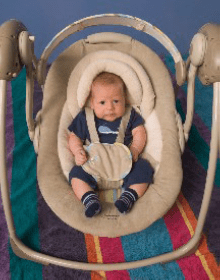What is Plagiocephaly?

What Is Plagiocephaly?
Plagiocephaly means slanted or flattening of the head.
What Causes Plagiocephaly?

Plagiocephaly can be caused by lying in one position too long with the head turned to only one side. This can happen in babies who sleep on their backs or spend a big part of the day in a baby car seat, bouncy seat, swing and/or stroller. The combination of sleeping on the back and pressure on the back of the baby’s head can create a flat spot.
Once the head changes begin, if the baby is not put in different positions, the flat spot may get worse.
What Can Happen?
The entire head can change shape, even the face! Without treatment, changes in face shape can lead to an eye imbalance and a change in jaw shape. If your baby's head still has a flat spot at 3 months, a molding helmet may be needed to improve the flat spot. Having plagiocephaly does not always mean that your baby will have developmental delays. Babies with plagiocephaly often have tight neck muscles. Having tight muscles can cause delays because the baby cannot move properly.Plagiocephaly Can Be Prevented
- Change your baby’s position often when awake.
- Limit the amount of time your baby rests in positioning devices – car seats, bouncy seats, baby swings and strollers.
- It is very important to put your baby on their tummy when they are awake and being watched. This takes the pressure off the back of your baby’s head, so there is less chance of developing a flat spot.
- Being on their tummy while you are with them will strengthen the neck, arms, and tummy and back muscles. With stronger muscles, your baby will be able to turn their head to both sides, which will help pressure on the same side of the head.
- The American Academy of Pediatrics recommends that babies lie on their back to sleep and have frequent supervised tummy time when they are awake.
Contact Information
- Children with plagiocephaly (abnormal head shape) should be referred to:
- Physical therapy right away at any age. Phone: 513-636-4651
- Cincinnati Children’s Plastic Surgery for assessment of plagiocephaly and potential helmeting at age 3+ months. Phone: 513-636-7181
- Evidence supports starting helmeting between 4-6 months. Babies less than 4 months typically don’t have enough head control to manage the weight of the helmet. There is still a chance to improve head shape without helmeting at that age.
- Helmet therapy is less effective in improving head shape once a baby is older than 9 months of age.



